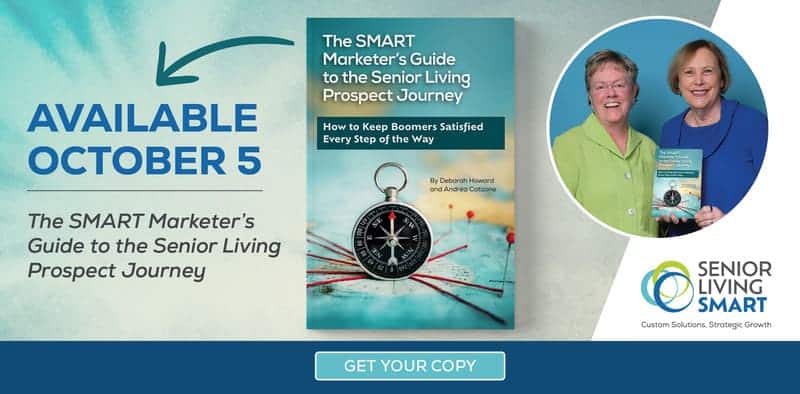How to Write a Great Senior Living Blog Post
This blog was originally published on 3/6/2020 and updated on 4/21/2025
We’ve discussed why all senior living websites should have a blog. Now, let’s talk about the anatomy of a great senior living blog post.
1. Always use subject matter experts.
We can’t stress this point enough: If you want blog content that stands a chance at ranking and converting amidst the glut of AI slop, interview subject matter experts (SMEs) in your community.
Remember, no other community has your activities director, head chef, nursing staff, etc. And AI doesn’t have access to these people or their insights, either. So, talk to your SMEs to make your content stand out.
Keep things organized and moving forward by creating an editorial calendar. It doesn’t need to be fancy, either. Add a working title (one that’s compelling and that includes a keyword phrase you’re targeting), any relevant notes, the due date, and the assigned writer.
Need ideas for topics? Turn to…
- FAQs. Think about the common questions people ask your sales team and/or the questions you get on Live Chat.
- Your competitors. Are they covering any topics you’ve overlooked? We’re not suggesting plagiarizing—the content you write should always be original—but you can certainly go to other sites for inspiration.
- Senior-focused publications. Both online and in print. Again, think inspiration.
- Your staff. And not just marketing and sales, either. Ask everyone—operations, dining, activities, and so forth—about topics they think would be important to cover. (Again, use these folks as subject matter experts and/or as guest contributors.)
- Analytics. Google Analytics and Google Ads reveal keyword phrases that are bringing people to your site. Could any of those keyword phrases become additional blog content?
- Keyword tools, such as SEMrush and Ahrefs, can provide excellent insights and ideas.
2. Focus on a keyword phrase (but don’t be spammy about it).
Again, always write for humans first, search engines second. You’ll find lots of advice online about where to place keyword phrases and how many times to use each phrase, but the truth is that no one knows what goes into Google’s algorithm.
Yes, it makes sense to use the keyword phrase in the title tag since that cues Google—and readers—what the blog post is about. And it makes sense to use it in your compelling headline. From there, just use the phrase—and various synonyms—naturally in your blog post.
Note: Google does tend to like an organized format, so if you can use the keyword phrase (naturally) in sub-headlines and bulleted/numbered lists, go for it.
3. Understand search intent and create blog posts accordingly.
We’re in the age of AI, which includes AI Overviews. When people conduct informational searches, they often don’t need to leave the search engine results page (SERP) because the answer to their query pops up in the AI Overview or another highly visible element, like the “People Also Ask” boxes.
Before we entered this era, a thorough informational blog post had a better chance of showing up on the SERP and getting clicks.
But times have changed.
That said, we’re not suggesting that you should stop writing informational blog posts. It’s still a smart strategy to include them in the mix. Optimize and format them for maximum visibility on the SERPs.
However, another item to consider adding to the mix is more “bottom of the funnel” blog content. We’re talking about content that focuses on keyword phrases with commercial search intent, meaning someone is much farther down the sales funnel.
Yes, this is a departure from the way businesses have been blogging for the last twenty years.
In the “old” days of business blogging, we were told that blog posts should be strictly informational and geared toward the top of the funnel. But that strategy is tough in the era if AI Overviews and the “zero-click search” world we find ourselves in.
Instead, write a blog post around a lower-volume search phrase with commercial intent that discusses your community as a potential option/solution.
For example, let’s say you have an award-winning community in Lakeland, Florida. Consider these keyword phrases:
- Average monthly cost for senior living: 590 monthly searches, informational search intent
- Best senior living communities in Florida: 30 monthly searches, commercial search intent
The first keyword phrase has informational intent. The searcher wants info on average costs. Maybe they’re just starting to consider senior living for themselves or a parent. Or maybe it’s simply a general curiosity. AI Overviews and industry associations dominate the SERP and will give the searcher a quick answer.
This doesn’t mean you should ignore the question. You could address it on an FAQs page or in a guide. But writing a blog post around it? Probably not the best use of your marketing budget.
The intent of the second keyword phrase is commercial. Think about someone who plugs that phrase into Google. They’re curious about “the best” — and not just the best anywhere, but in Florida. Money may or may not be a factor. When someone wants “the best,” they often don’t care how much it costs.
You could create an in-depth blog post highlighting some award-winning communities in Florida, including yours. And you could discuss what makes your community even better than the other “winners.”
Yes, it would be a bit more self-serving and even promotional. But the search intent indicates the searcher WANTS to know what the best community is and would be open to reading all the reasons yours is.
4. Mind your grammar, spelling, and punctuation!
This matters to readers AND Google. (Google is wicked smart.) Nothing can torpedo a great topic like lousy mechanics.
If the person writing the blog post isn’t a writer by trade, that’s OK—just make sure you have someone with writing/editing chops who can review the work before it goes live.
HINT: AI tools, like ChatGPT, are great at providing feedback on blog posts. Here’s an example prompt, playing off the keyword phrase we discussed earlier: “You’re looking for info on the best senior living communities in Florida. You’ve just read this blog post. What info is lacking and where could the blog post be stronger, more compelling, and more convincing?”
5. Watch your tone.
Your blog is a great place to be friendly and conversational. And yes, you can still be those two things while also being professional.
Avoid “stiff” writing. It’s OK to use contractions, end sentences with prepositions, start sentences with “and” or “but,” and write fragments, all of which will help support a friendly, approachable, conversational tone. (Read more about style and tone here.)
HINT: You can ask ChatGPT to provide feedback on your blog post’s tone, style, and readability. Here’s how the prompt might look: “Please review this blog post, which is written for women with adult parents in need of assisted living. The tone should be empathetic and helpful. Please evaluate the post’s readability, including specific suggestions on where we can improve the copy.”
6. Write about those things that no one else wants to talk about.
OK, this tip isn’t for every senior living community, but if you truly want your community to stand out in the sea of sameness, then this could be a good differentiator.
Talk about hard things, but in a friendly, approachable way. Example: Tips to Prevent UTIs for Healthier Bladders.
Or how about this: Sex After 70 – It’s Good For You! You get the idea. These aren’t the sorts of topics you’ll see on many other senior living community blogs, but they ARE the types of topics that—if done right—can help your community stand out in a good way.
7. Consider hiring a professional writer.
So, here’s the thing: lots of people can write, even though they don’t wear the label “professional writer.” As long as the mechanics are sound (see point #4 above), it’s good to have a variety of voices and styles on your blog. So you might not need a professional writer, provided you have a solid marketing person who can lead the efforts and proofread/revise posts as needed.
That said, if you don’t have a person like this available on staff (and not all communities do), then yes—it does make sense to hire a professional writer.
But hiring a pro doesn’t mean you should get lazy about having original content. You should make sure the writer has access to “people on the ground” (in other words, the subject matter experts in your community). Otherwise, you can expect generic content that readers can find anywhere (like “5 chair exercises for seniors”).
8. Tell people what they should do when they get to the end.
When people get to the end of the blog post, tell them what to do. This is called the call to action or CTA. It might be links to related content, an invitation to subscribe to the blog, or a download. Bottom line: Engage them further. They got to the end of your blog post, after all, so you have their attention.
You can also experiment with providing CTAs throughout the content. Just make sure these CTAs don’t distract people. You can determine this through your website and blog analytics by seeing how long people stay on the page or even if they get to the bottom of the page.
Speaking of analytics . . .
9. Measure results.
The goal is to write content that attracts the right prospects to your site. Analytics can tell you if your content is doing exactly that. Study the blog posts that convert. What about them is driving conversions?
That’s another good task for ChatGPT: See if it can tease out themes or reasons for high-converting blog content. Then, based on that analysis, ask it to suggest blog content that might get similar results.
At the same time, pay attention to lower-performing blog posts. What can you do to improve performance? Focus on a different keyword phrase? Go longer? Reformat? (Again, ask ChatGPT to analyze.)
It takes less time and money to fix/tweak existing content than it does to create new stuff, so you might as well spend the time getting ALL content to hum.
Experiment with page titles, try tweaking/revising sections, re-format, add different CTAs, and so forth. If you substantially change a blog post, add a note somewhere that says “Updated on THIS DATE” and consider republishing it to gain some traction.
And don’t forget to resubmit the URL to Google Search Console so that Google can recrawl the page and serve it up in relevant searches.
10. Lather, rinse, repeat (aka: do more of what works).
Blogging is a long-game. Do more of what works, tweak and improve what’s lagging, and keep an open mind when it comes to trying something new and different.
Need help with blogging?
We have writers, editors, and strategists available for short-term or longer-term contracts. Choose what works for your situation. Let’s chat about it.













This was a very informative article – thank you!
Thank you for this very informative article which helps me understand the importance of maintaining a good relationship towards elderly people and also to have a good relationship to them. I also read a related article to this at “seniorlivingexperts.com”.
My Living Choice senior living directory is to help you find the best options for you or your loved one, to ensure you pick the best living environment for your or their needs. We provide powerful, simple, and digestible information all in one place so you can explore your Senior Living options. Our senior living communities provide different types of care & amenities are: senior living, independent living, nursing homes, respite care, memory care, onsite medical staff, housekeeping, planned activities, theater, and more. Explore our Senior Living Directory to find the top communities in your area.
This is a interesting blog! It is worthy of your time! Hope to read more of your post soon! Good Job!
Hey, thank you for this great article on senior living communities. we would love to work with you we are also working on senior living communities. please check our website, https://www.thegoldenestate.com/
Great info about senior living blog post. Often I find the ways which help me to increase my senior living website traffic, blog post is the best way to increase.
Explore top-notch at-home senior care options in Canada through our website. We provide valuable resources and guidance to ensure your loved ones receive the compassionate care they deserve.
Such a thoughtful post with practical direction! One point that truly clicked with me was the idea of writing from the reader’s perspective—especially important in elder care topics like seniors home life or the daily realities of an old age home. I’ve come across care centers where heartfelt, people-first content builds trust more than anything else. It reminds me of how some Chennai-based elder care initiatives create deeper connections through empathetic writing. Sharing real experiences and genuine care truly makes a difference. This blog definitely encourages creating meaningful content that supports both families and the elderly.